Figuring out how to group students for guided reading is no small task.
What data should you use to group students?
What’s a good assessment tool for getting that data?
Can you put students at different reading levels into one group?
In this post, I’ll tackle all of these questions and more! Gathering Data
Gathering Data
Assessments
Before we can group our students, we have to gather some data. My assessment of choice is the Fountas and Pinnell Benchmark Assessment System (by Heinemann). You can purchase kits in English or in Spanish.
You administer the F&P assessment by listening to a student read leveled books, taking running records, and discussing the texts with the student.
As with any one-on-one exam, it takes quite a bit of time—especially if you are a classroom teacher! However, the information you get from giving the assessment is well worth it.
You learn about each student’s…
- Instructional reading level (this is what you want to target for guided reading)
- Independent reading level
- Use of decoding strategies
- Fluency (reading rate, but also expression, attention to punctuation, etc.)
- Comprehension abilities
- And more!
The F&P assessment gives you a rather complete picture of each of your students as readers.
That said, it can be a bit expensive to purchase if your school doesn’t already have it. If I’m in a situation where I don’t have access to the F&P assessment, I can:
- Use the Reading A to Z benchmark books (taking running records and asking comprehension questions)
- Use books I already own to administer running records and create comprehension questions (you can find book levels using the Scholastic Book Wizard, or you can search by reading level using the website Booksource)
Of course, these methods aren’t as reliable for determining an instructional reading level as is using the F&P assessment. But sometimes we have to make do with what we have! 🙂
Assessing Kindergartners
Assessing kindergartners at the beginning of the school year also presents some unique challenges. I have almost always worked in low-income schools where students did not attend preschool and are not yet reading when they come into kindergarten.
So…what do we do in this situation? Well, I don’t administer the F&P assessment at the beginning of kindergarten (unless I know for sure that a student is already reading). I can use other assessments to get more valuable information.
I like to assess my kinders on:
- Letter sound knowledge
- Letter name knowledge (I have mixed feelings on this…being able to name the letters is not all that helpful in decoding emergent texts, but it is a foundational concept that can be a little bit helpful in making grouping decisions.)
- Concepts of print knowledge (I use a local assessment to determine this, but I believe Marie Clay has an observation survey to test things like concept of word, left-to-right directionality, etc.)
- Ability to pretend-read emergent texts (I usually teach the entire class how to read 1-2 emergent texts and then see how students do when re-reading the texts on their own.)
Analyzing Data
Data is no good unless we use it, of course! So after I’ve administered my assessment(s), I usually sit down and put the information into a spreadsheet. This post has a spreadsheet freebie that you can use.
But when it comes to actually forming the groups, I prefer something a little more low-tech…
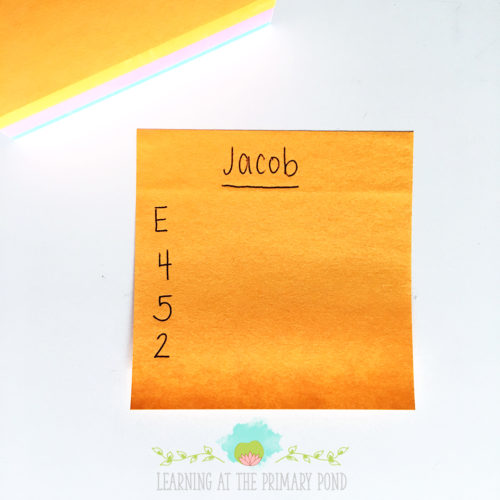 I know, I know…not very fancy. But it works for me! In the past, I’ve been responsible for grouping students in K, 1st, and 2nd grade for interventions. That’s a lot of kids, and visually laying things out for myself is REALLY helpful!
I know, I know…not very fancy. But it works for me! In the past, I’ve been responsible for grouping students in K, 1st, and 2nd grade for interventions. That’s a lot of kids, and visually laying things out for myself is REALLY helpful!
So what goes on each sticky note? A couple of things:
- Instructional reading level (I use the Fountas and Pinnell guided reading levels.)
- Comprehension score at their instructional reading level
- Comprehension score on the text one reading level lower than the instructional level
- Reading rate (I use my own rating scale of 1-3 for simplicity. The F&P assessment system also has a fluency rating scale that you can use instead. When I’m making guided reading groups, I don’t worry about other fluency behaviors like expression or attention to punctuation—I’ll explain why later on.)
Again, the Fountas & Pinnell Benchmark Assessment System gives me the data for all of this.
So why do I write these four things on my sticky notes?
Well, the instructional reading level part is pretty obvious—that is a REALLY good starting place for grouping kids! Once I have filled out a sticky note like this for each student, I take the sticky notes and group them by instructional reading level.
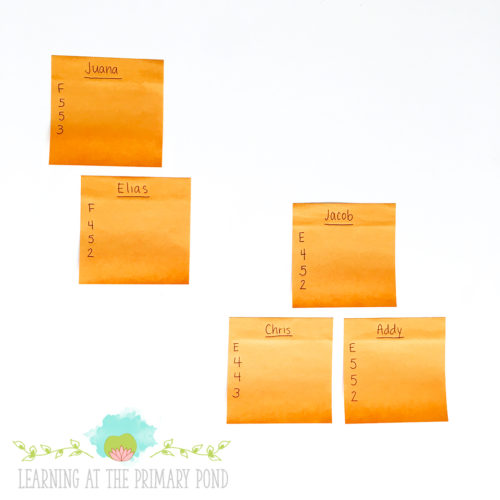 (These names and scores are fake for privacy’s sake…and yes, I work with more than 5 students ;-))
(These names and scores are fake for privacy’s sake…and yes, I work with more than 5 students ;-))
However, my work is not quite done! I mean, I guess if you have perfectly sized groups AND a perfect number of groups (I aim for 5 in a regular-sized class) AND the rest of the data on the sticky notes seems comparable among all students in each group, then you can probably call it quits. But that doesn’t usually happen to me!
At this point, I usually see some problems or challenges arise. Potential issues:
- Some groups are too small (1 student does not make a guided reading group…you can’t have any peer-to-peer discussion!)
- Some groups are too large (6 is my max, and I like to stick to 5 or less in kinder/early 1st grade)
- There are some significant outliers in reading rate
Reading Rate Outliers
First, let me address the “outliers in reading rate” issue. Sometimes I’ll have a group of readers who have the same instructional reading level, BUT one of the students reads verrrry slooowwwllllly (even if decoding and comprehension at the level are fine).
When I see this, I typically move the student “down” one group. Otherwise, what will happen is that the student is left far behind during guided reading. The other group members finish the text in a reasonable amount of time, and they are ready to discuss the book long before that particular student is ready.
In my opinion, we are NOT disadvantaging a student by placing him in slightly easier text so that he can improve his fluency. If we try to make a student read texts that take him forever to finish, then his mind won’t be free to focus on comprehending the text. (Not to mention there will be all kinds of logistical problems with timing the post-reading discussion.)
Less frequently, I find that I have an “outlier” who reads much, much more quickly than his/her group mates. This is a bit easier to deal with, because you can always have fast finishers reread, hunt for words with a certain pattern, or look for new vocabulary words.
However, if you truly think that the student would do well with a challenge, you can cautiously try bumping him up by just one reading level. (I rarely do this). I would just monitor that student’s progress and use frequent running records to ensure that the student quickly adjusts and is successful with the slightly harder texts.
Grouping Size Problems
Nine times out of ten, after I sort the sticky notes, I’ll find that some groups are too small, and some are too large. This means that I have to put students at slightly different reading levels in one group.
While it’s not ideal, what else can you do? You don’t want to have SO many different reading groups that you hardly ever see students. And you don’t want your groups to be rushed just for the sake of “getting to” all of your students in a timely fashion.
Honestly, reading level isn’t an exact science. I find that I have to make adjustments to the groups even after I do all of this data crunching and sorting. It’s all about tuning in to how your students are doing and making changes as necessary.
So don’t stress if you have to combine reading levels in one group. 🙂
At the same time, you still have to be careful when you do combine levels. You don’t want students to be unsuccessful or completely bored during guided reading. So here are my own personal “rules” that I follow when combining levels:
- I make groups with no more than 2 consecutive reading levels (i.e. F and G).
- I avoid combining levels when there is a significant jump in text complexity between the levels (B to C, D to E, K to L, and probably some other ones that I’ve missed).
- I do not put a student into a higher group if his reading rate is low. If he is already a slower reader, putting him in challenging text will slow him down even more and present challenges for pacing the guided reading lessons. (Of course, reading expression and attention to punctuation are important in measuring fluency too, but they do not affect the logistics of a guided reading lesson as much as reading rate does.)
- If a student did only marginally well with comprehension at her instructional level AND marginally well with the text one level below her instructional level, then I put her down to the lower level. This will provide her with an opportunity to really work on comprehension before tackling slightly harder text. (This is why I include BOTH comprehension scores on the sticky note—so that I can see how she did with comprehension at more than one level and make a more informed decision.)
Again, when you have to make these tricky decisions, keep in mind that you can always go back and adjust later on. I do it ALL the time! 🙂
Other Challenges
By this point, I’ve usually sorted and re-sorted the sticky notes a couple of times. Sometimes I will still have one student who doesn’t seem to fit into a group. In this case (if I’m teaching in the classroom), I have a couple of options:
- Meet with the student individually and present her with texts at her instructional reading level. Include her in small group reading instruction through strategy groups (having students at different reading levels come together to work on a strategy that is applicable to all of their levels).
- Ask around to see if the student could participate in guided reading groups in another classroom (same grade level or one grade level up…I try to avoid sending a student to a lower grade, but you could also turn it into a reading buddies and have them help a younger student read!)
- Meet with the student individually, presenting her with texts at her instructional reading level. Additionally, have her participate in the lowest guided reading group by reading aloud the text to her or with her before the group meets. This usually provides the support necessary for a struggling student to be successful with a more challenging text.
Final Thoughts
So there you have it! That’s the process I use when grouping students for guided reading. I go through this process whenever we administer a formal benchmark assessment, but I also take daily running records and make adjustments throughout the school year.
If you’re looking for resources to teach guided reading, check out my guided reading resource packs. They come with printable books, lesson plans, assessment tools (like level-specific checklists!), word work activities, and more!
Happy teaching!

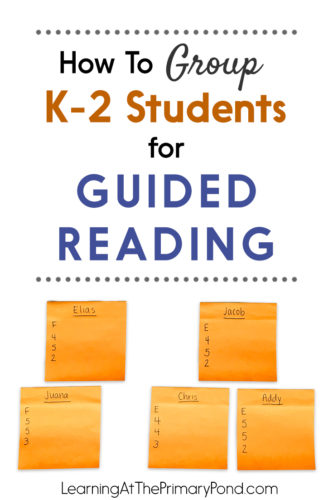 Gathering Data
Gathering Data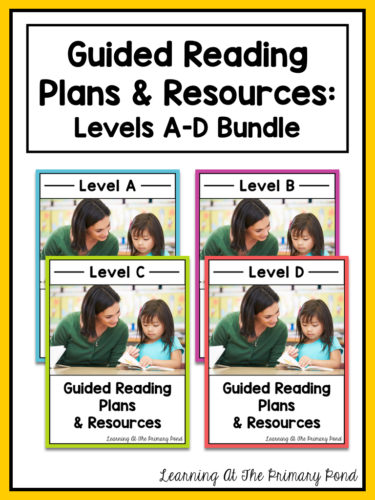
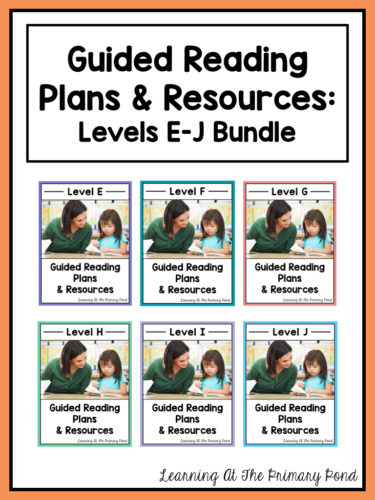
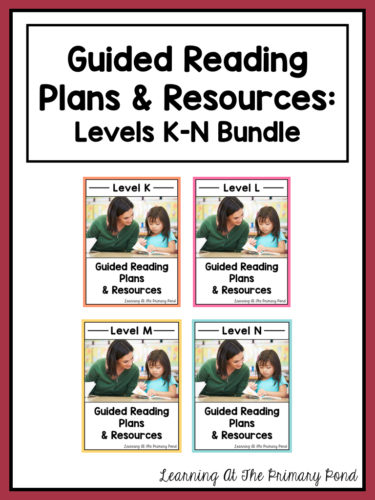

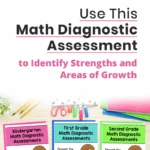
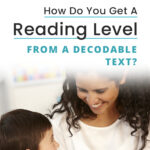
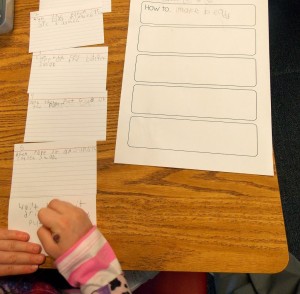
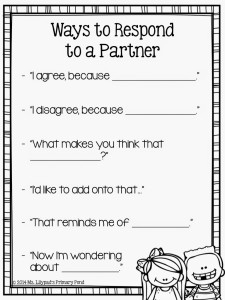
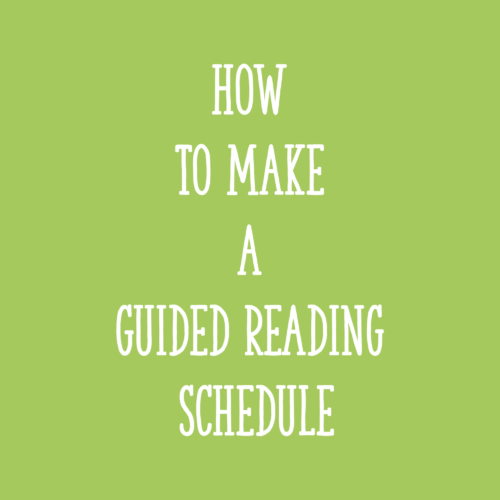






Excellent, how can I get the spreadsheet? Already planning for next year
Hi! It’s in this post: https://learningattheprimarypond.com/blog/how-to-form-guided-reading-groups-by-using-multiple-data-points/
🙂 Alison
What tool do you use to get their comprehension score?
The comprehension scores are part of the Fountas & Pinnell Benchmark Assessment System. 🙂
Alison
Hi,
Thank you for sharing. I have a question regarding the sticky note. What do letters and numbers mean in each sticky notes?
Thank you!
Hi Jennifer! Here are the numbers:
– Instructional reading level (I use the Fountas and Pinnell guided reading levels.)
– Comprehension score at their instructional reading level
– Comprehension score on the text one reading level lower than the instructional level
– Reading rate (I use my own rating scale of 1-3 for simplicity. The F&P assessment system also has a fluency rating scale that you can use instead. When I’m making guided reading groups, I don’t worry about other fluency behaviors like expression or attention to punctuation—I’ll explain why later on.)
Alison
What do you suggest for kindergarteners who are still not at a level A in January?
Hi Michele! I’m planning a future post all about working with Pre-A readers, so look for that in April. 🙂 I also have a Pre-A guided reading resource: https://www.teacherspayteachers.com/Product/Pre-A-Guided-Reading-Activity-Binders-3571521
For your kiddos who are still below level A, I might try some Level A or even Level B books with them – but provide them with lots of support. In this blog post, I go through some ways that I do that: https://learningattheprimarypond.com/blog/what-to-do-when-level-a-books-are-too-hard/
I hope this helps!
Alison
If a child reads and passes a level K with great accuracy and comprehension do you use level K books in guided reading instruction or would you use L books since it is guided?
Hey there! If his accuracy is above 94% and comprehension is very strong, I think level L would be a good choice. If you try Level L, you’ll want his comprehension to still be pretty good and decoding accuracy to be between 95-97% (or higher accuracy and slightly lower comprehension). And of course, if it doesn’t feel right, you can always put him back to down to level K! 🙂
Alison
Hi, for kindergarten, when do you start reading groups? Is there an assessment sheet for kindergartners for lettersoynd, Lester name, concept of print?
Hey! I start reading groups after students have learned independent work skills. You can read more about how I organize that here: https://learningattheprimarypond.com/reading/how-to-start-kindergarten-centers/
I do have a little assessment freebie that addresses some of the concepts you mentioned! https://www.teacherspayteachers.com/Product/Preschool-or-Kindergarten-Pre-Assessment-301956
Alison